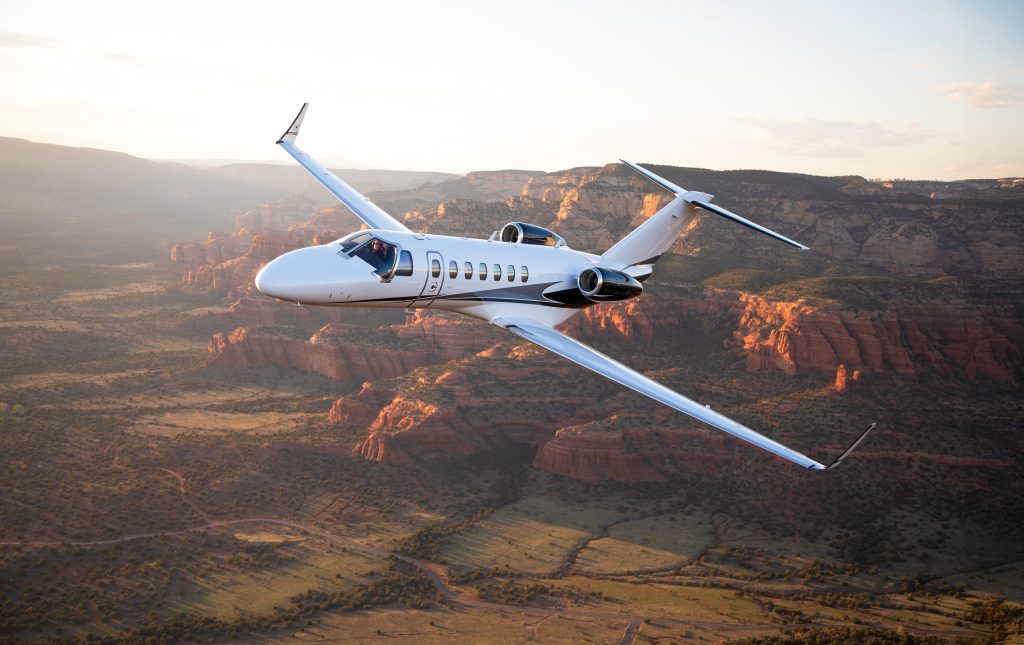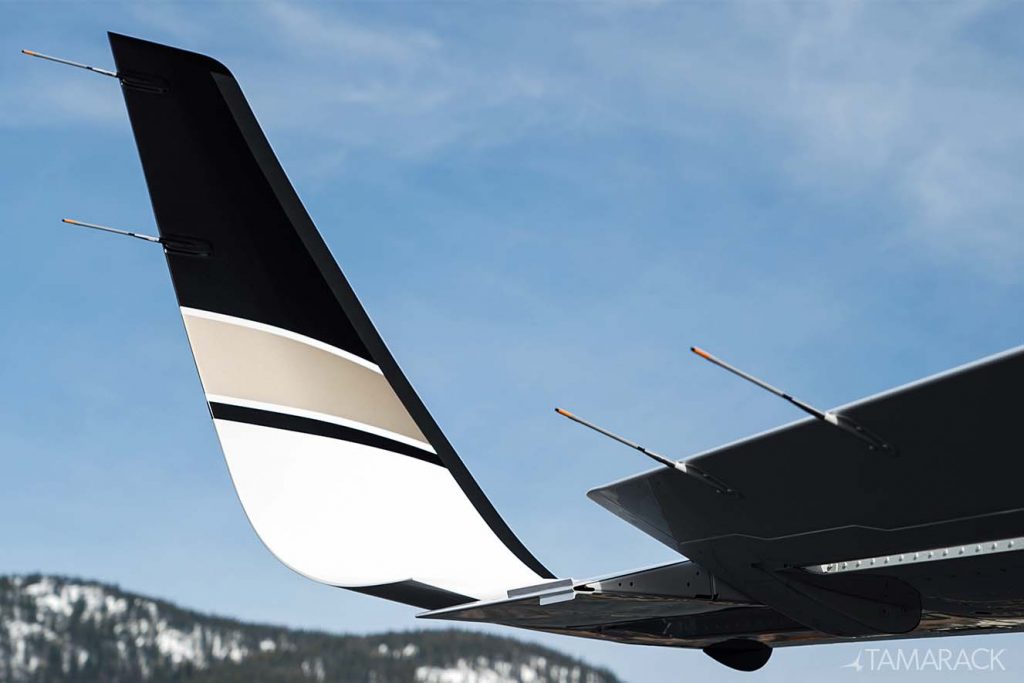Active winglets by Tamarack Aerospace Group in Sandpoint, Idaho improve takeoff, landing, fuel savings and more. Why aren’t you using them?

You could say that James Benham, CEO of JBK (www.jbknowledge.com), has his head in the clouds, and you may be right. Benham may spend more time in the sky than on the ground. As an entrepreneur, he flies domestically every week, hitting cities in Illinois, Florida, Wisconsin, Massachusetts, and New York. Flying in his 1997 Cessna CitationJet, Benham said the only place he doesn’t fly is out of the country. Benham bought his jet in 2020 and added Tamarack Aero winglets in 2021. He said the winglets are “a total game changer” for his aircraft.
Jacob Klinginsmith, president of Tamarack Aerospace Group, said that winglets have been around for over 100 years. But the active winglet design created by Tamarack founder and CEO, Nick Guida, certified in 2016, elevates the performance of the technology. Tamarack Aerospace now has 28 employees in Sandpoint, Idaho.
Chief Engineer of Tamarack, Nathan Cropper, said that through testing, prototypes, and certification, the active winglets are ready for applications on business, commercial, and military jets.
Benham glowingly shared his love and the benefits of the active winglets for his business jet, “They allow me to fly higher and faster. I can get flying a lot faster by getting to cruising altitude of 41,000 feet in 30-33 minutes.” He said it would typically take him 90 minutes to reach 41,000 feet because, after takeoff, he must maintain his flight level at 36,000 feet before transitioning to 41,000 feet, which is his desired altitude.

The application of the winglets to the end of the wings on Benham’s jet added 2.5 feet per wing, for a total of a five-foot extension on the plane. He said the magic in the winglets is not the extension, but the electro-mechanical function within the winglets that reduces load. Klinginsmith described this as, “Traditionally, with winglets, you are adding the vertical fin, and the engineering says if we make the fin bigger, we must reinforce it more; if we make it smaller, we get less benefit, but we don’t have to reinforce it more.” He said with their technology, they can do more with aerodynamics, which alleviates the need for further wing reinforcement. Tamarack’s capabilities on their active winglet fact sheet demonstrate, “proprietary technology designed to optimize aircraft performance, reduce drag, and improve fuel efficiency across a wide range of platforms.”
Since their winglet technology certification, Tamarack has been working to sell the product to business jets and commercial airlines; they also offer additional engineering services to regional businesses. Klinginsmith said their facility has over 17,000 square feet across three buildings. They have an administrative building, a production and installation hangar, and an R&D facility where their engineers take on additional engineering services work in the aerospace industry.
Cropper said both he and Klinginsmith attended the University of Idaho, along with several others in the organization. Cropper also serves as an FAA Designated Engineering Representative (DER) at Tamarack’s location. He manages 10 engineers and designers for both internal development of the winglet program and external engineering projects. He said they do everything, from testing and certification to flight testing. “We are a group of engineers that like to solve problems and get our hands dirty.”
For external customers, Tamarack offers “small box development, like hardware design, such as an electrical or mechanical component, to designing a clean sheet aircraft, including aerodynamic loads.” They have also undertaken helicopter projects and integrated complex hardware into airframes. They can define requirements for system architecture for Part 23, 25, or 27.
He complimented his team by sharing how well they identify the customer’s critical needs holistically, going so far as to review detailed designs within the airframes while rapidly reporting recommendations. “We have a whole bunch of generalists, and we also have a few people who are experts in certain areas. We have a broad knowledge base to solve problems for people,” Cropper shared.
Cropper noted that one of their long-term client relationships for external engineering services involved a start-up with an integration project aimed at enabling them to meet certifications. “The relationship has grown as the company has matured; they’ve added people to their team, but they only have a couple of people focused on aerospace.” He said that, as engineering experts, they augment their customers’ team. “Relationship-wise, we value in-person visits and face-to-face time.” He mentioned that they prefer to develop their interpersonal relationships while working on projects. Benham said, “They are a great company, the people there are awesome, the CEO and president, the whole crew there has been great to work with.”

According to Klinginsmith, one reason their team can produce results is their thorough passion for aviation. He shared that half of the team are pilots out flying on the weekends. “This is what we do during the week for work, but also, we do aviation for fun, not just as a job, but a passion.” He said their team is a very technical crowd.
Nick Guida, CEO of Tamarack, created the active winglet model. As the story goes, he conceived the idea when leaving a Steely Dan concert one night. But the crux of the matter is that Guida created a new solution from a decades-old technology. Klinginsmith said winglets alleviate drag on the aircraft and increase efficiency due to the upturned wing and the extension on the active camber surface. “A camber surface looks like a short aileron, but is a dedicated surface, just like an aileron surface that is faired; the surface deploys up or down to relieve the load up or down on the wing to reduce stress. There is a controller that lives in the belly of the plane, which senses what is going on with the flight conditions, and it is predictive,” Klinginsmith said. He also added that sustainability is one of the main reasons for adding winglets. “Sustainability is making the most of the resources we have; if we can help aircraft be more efficient, that is sustainability.”
Klinginsmith mentioned, “There are other technologies coming online; propulsion, electricity, or hydrogen, and blended wing bodies.” Their team, along with their customers, is exploring new technologies to achieve fuel savings and efficiency.
While Tamarack has been engaged with the business jet market, there is an opportunity for expansion into the commercial aerospace and military markets. He added that there is tremendous opportunity for aerospace OEMs to improve their efficiency by adding active winglets. “We have the next best version of winglet technology; we are very passionate about getting it into the industry so that it can benefit all the aircraft that are there now, and also in future aircraft design.” He said the technology scales across future models. Klinginsmith said, “We’ve talked with a lot of the airlines; the feedback is unanimous — they want the technology. They want assurance that the certification and engineering is done, as there is a hurdle with investment costs to scale the technology from business jets. The A320 is one of the biggest contributors to aircraft emissions.” He said that with narrow-body aircraft, there is an opportunity to scale with economics and sustainability.
With an eye to military applications, Klinginsmith said keeping the aircraft aloft is mission-critical for reconnaissance, so the military seeks to add range to its aircraft. He noted also that the Air Force spends billions of dollars annually on fuel, and they are exploring cost-saving options. He said the winglets can make a tremendous difference in cost savings for the military.
Benham observed, regarding his business jet, that maintaining it without the winglets wouldn’t be as effective. But, with the Tamarack winglets, “They are remarkable — a neat piece of engineering technology.” He said they provide fuel savings of 20% on average. When he stops in other airports around the country, his plane attracts the attention of other business jet pilots.
“I give a glowing recommendation,” he said. He shares with others how the winglets have changed his comfort level overall, including improving his takeoff and landing distances, fuel savings, and peace of mind regarding safety. “They are big winglets which are not factory on this plane; they are noticeable. It makes it a super-duper airplane. You can carry more passengers and baggage weight.” He said overall, the winglets extend the life of a plane and allow older planes to fly longer with better performance.



